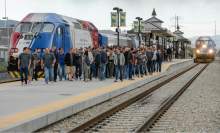This is an archived article that was published on sltrib.com in 2016, and information in the article may be outdated. It is provided only for personal research purposes and may not be reprinted.
Farmington • The Utah Transit Authority says that up till now, it promoted "transit-oriented developments" (TODs) around train stations only to increase its ridership and revenue.
Now it sees a higher calling for them: Help the Wasatch Front handle a projected doubling of its population by 2050, while decreasing air pollution, traffic congestion and water use — and help preserve open space elsewhere.
Such developments near transit could help achieve these goals by sending growth upward — instead of outward into increasingly scarce undeveloped land — with taller buildings and higher-density housing for people who want services within a walkable distance or accessible by transit.
Without such TODs and "without a robust transit system, we will not be able to absorb the growth that is coming in a way that maintains the great quality of life in this region," Andrew Gruber, executive director of the Wasatch Front Regional Council, told the UTA Board.
It used a retreat Monday to discuss what it calls its "TOD reset," to rewrite policies and goals to foster and reshape more of these developments — including ensuring UTA involvement is ethical and transparent to avoid some scandals that occurred in the past. UTA officials say they hope to develop new TOD policies and procedures by year's end.
Transit-oriented developments are clusters of housing, office and retail around stops for trains or other frequent transit. Examples include City Creek Center in downtown Salt Lake City next to TRAX lines or the large Farmington Station next to FrontRunner.
While most are private ventures, UTA occasionally has used land it owns to become a partner in some developments.
Millennials and baby boomers — along with employers and businesses that attract them — are especially interested in such centers, said Gruber, because they avoid the need for a car, and reduce traffic and pollution.
If much of the coming growth is handled this way, he said, that could preserve open space and single-home areas elsewhere.
"The goal we're trying to achieve is to help our communities thrive," Gruber said, not just boost transit use.
Ari Bruening, chief operating officer of Envision Utah, said his organization recently completed a study that included participation by more than 50,000 residents about how they would like to handle expected growth.
It found that 82 percent prefer a scenario that depends heavily on such centers — with taller buildings, smaller lots and dense housing.
"This is what Utahns said they wanted. The question is how do we get there," he told the UTA Board.
UTA General Counsel Jayme Blakesley said the agency's policies to date had viewed such projects only as a method to increase ridership and revenue. But it has been studying policies at transit agencies elsewhere and found many incorporated other goals that UTA also is now considering.
They include using TODs to support regional planning, foster sustainable development, help form partnerships with local governments and developers, promote economic development, promote multi-modal connections and solve parking problems.
Some board members added that new policies should also ensure an "ethical, transparent structure" for UTA involvement with the developments.
Such developments have been controversial on occasion.
A legislative audit in 2014 questioned some possible sweetheart deals with developer Jeffrey Vitek after he had bought development rights near a FrontRunner station from former UTA Board member Terry Diehl.
The agreement included, the audit said, "prepaying" Vitek $10 million to build a parking garage that was never built, without obtaining the money back in a timely manner. It also said a Vitek company was chosen for another development even though it did not provide financial information required from other bidders.
Amid this criticism, the UTA Board enacted such auditor-recommended reforms as requiring independent review and board approval of TOD agreements, and establishing an internal, multidisciplinary team to review TOD proposals and operations.
While many TODs use only technical help from UTA, the agency has utilized some of its own land to become a partner in TODs at five sites: the Clearfield FrontRunner station, the Meadowbrook TRAX Station; Jordan Valley TRAX Station, Sandy Civic Center; and the South Jordan Station.
UTA said Monday that it has land that could lead to involvement at 11 other existing train stations: Ogden Transit Center; Roy Station, North Temple Station, Central Pointe Station, Draper Town Center, American Fork Station, Orem Intermodal Center, Farmington, Ballpark, Salt Lake Central and Provo Intermodal Center.



